The Caro-Kann is named after the European masters Horatio Caro and Marcus Kann. Of the two, Caro had the slightly more distinguished playing career, having participated in a number of strong tournaments around the year 1900.
It would be fair to say, though, that if it wasn’t for their contribution to opening theory their names would have sunk without trace in the annals of history. Individually, they are totally forgettable but together they have achieved great fame. As Raymond Keene put it, Caro and Kann have become as inseparable as Tweedledum and Tweedledee.
How Does The Caro-Kann Start?
The Caro-Kann defense opening is introduced by the moves 1.e4 c6 and has long been one of Black’s major defenses to 1.e4.
Starting position of the Caro-Kann Defense
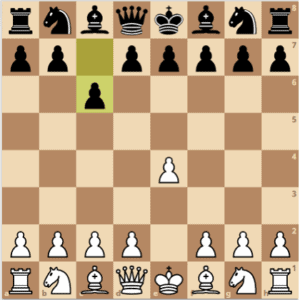
The idea behind 1…c6 is simply to support the advance 2…d5. Now if White captures on d5 Black will be able to recapture with the pawn, maintaining an equal position in the centre. If Black had started with 1…d5 then this would not be possi- ble and he would have to recapture with a piece. This (1…d5) is the slightly less respectable Scandinavian Defence (otherwise known as the Centre Counter).
Is the Caro-Kann Opening Solid or Sharp?
In chess there are two distinct approaches to playing the opening with Black. The first is to try and negate White’s advantage of moving first through careful, no-nonsense play. The second, more risky strategy is to counterattack at once, concentrating more on one’s own ideas than on what White is doing.
The Caro-Kann, with the exception of one or two sidelines, belongs firmly to the first group. It is an opening that should appeal to those who like a solid structure with relatively easy development and do not consider a draw with Black to be an unmitigated disaster. This doesn’t mean that the game will not become complicated, just that the onus is mainly on White to sharpen things up.
Introducing The Caro-Kann (Brief Explanatory Video)
Caro-Kann Classical Variation (Old Mainline)
The Classical Variation of the Caro-Kann begins with the moves: 1.e4 c6 2.d4 d5 3.Nc3 dxe4 4.Nxe4 Bf5

The starting position of the Classical Variation
The Classical Caro-Kann, as the variation with 4…Bf5 is usually known, enjoys a reputation as one of the most rock-solid lines in chess. Although the variation has been spiced up a little in recent times, it is not played by those who are looking to win at all costs.
It is primarily a variation which Black employs when he wants to avoid defeat, or a variation you can employ against an aggressive player who you feel may overpress. In fact the variation is so solid that many white players, including myself, have changed their repertoire after failing on countless occasions to breech its defenses.
The Classical Caro-Kann has a great history. Many of the World Champions have employed it regularly such as Capablanca, Botvinnik, Petrosian, Karpov, the young Kasparov and the old Tal. But others such as Fischer and Alekhine steered clear of it. It was not their territory. Anand, Carlsen and Dreev are some of the modern day talents who use it.
Strategies in the Classical Variation
4…Bf5 is clearly a logical move. Black develops his bishop to its best diagonal with gain of tempo. One could hardly ask more of a move. Afterwards Black usually just develops as quickly as possible: …Nd7,
…Ngf6, …e7-e6, …Be7 (or d6) and …Qc7 are all typical moves, while he will usually need to play …h7-h6 when White starts to harass his bishop on g6. Black can castle either side and he will be looking to free his position with …c6-c5 at some point. On other occasions, especially when White has played e4, he may essay …b5 in order to wres- tle control of the d5-square from White. Black usually has a bit less space but it is rare that his pieces become so congested that they have to fight each other for the same squares.
White will normally advance his h-pawn to gain space on the kingside and exchange off light squared bishops. This is because he usually castles queenside and if he leaves the bishop on h7 pointing towards his king he may live to regret it. White’s main strategic aim is to establish a powerful knight on e5. Black will always be able to capture this piece but it usually means exchanging one disadvantage for an- other. One of White’s other aims will be simply to avoid excessive simplification.
In this first section we shall be looking at some of the lesser-played lines after 4…Bf5. Afterwards we move on to the old main lines while in the next chapter we shall look at the modern and (slightly) more dynamic way of playing the variation for Black.
5.Ng3
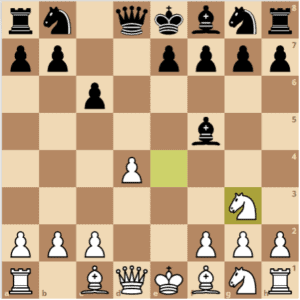
As White has no good way to maintain his knight in the centre (5.Bd3 Qxd4) he has to move it. Occasionally 5.Nc5 is played. But on the vast majority of occasions White retreats to g3 in order to attack the bishop.
5…Bg6
Funnily enough, if Black overlooked the threat to his bishop and played 5…Nf6 then after 6.Nxf5 he would still be able to save himself with 6…Qa5+ and 7…Qxf5. Black players, however, prefer to keep their strong bishop.
5.Bc4
The main line is 6 h4 and that is the subject of the next section and the next chapter.
6.N1e2 received a thorough going over in the 1960 Tal-Botvinnik World Championship
TIP: Buy the book of this match. There are plenty of Caro-Kann’s and Tal was a wonderful writer.
Tal’s idea was to play Nf4, Be4 and sacrifice a piece on e6 (and he did manage this on one occasion) but the variation has been neutralized by the continuation 6…Nf6 7.Nf4 e5!:
a.) On 8.dxe5 Black should prefer 8…Qa5+ followed by 9…Qxe5 to exchanging queens on d1.
b.) 8.Nxg6 hxg6 9.Be3 Nbd7 10.Qd2 exd4 11.Bxd4 Bc5 12 0-0-0 0-0 is about equal.
6…e6
Black can also play 6…Nf6 but this is likely to transpose back into the main line. He cannot get by without …e7-e6.
7.N1e2
The reasons for this slightly odd-looking move are twofold:
- White remains free to advance his f-pawn
- White can play Nf4
7…Nf6
7…Bd6 is an important alternative move order designed to draw the sting out of the f4-f5 plan we see in the main line. For example, if White now continues with 8 0-0 Qe7 9 f4 then Black can play 9…Ne7, making it harder for White to play a successful f4-f5. After 7…Bd6 many White players give up on the idea of a quick f4-fS and choose one of the following variations:
a.) 8 h4 h6 9 Nf4 Bxf4 (Black didn’t want to retreat his bishop to h7 as this would allow a white knight into h5) 10 Bxf4 Nf6. The bishop pair must give White a small advantage but Black is very solid and won’t be easy to break down. I know from experience!
b.) 8 Nf4 Qh4!? 9 Ngh5 Bxh5 and now 10 Nxh5 leads nowhere after 10…Nf6, as White loses his knight if he takes on g7, while 10 Qxh5 Qxh511 Nxh5 g6 12 Nf4 Nf6 may leave Black fractionally worse, but is hardly the sort of position to trouble a good solid Caron. Even Kasparov got absolutely nowhere when he had this position against Topalov.
8.0-0 Bd6 9 f4
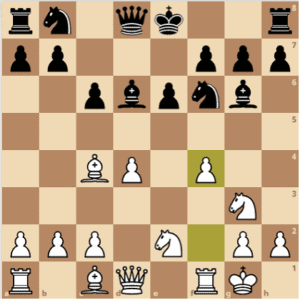
White plans f4-f5
Now Black must prevent White from playing f4-f5. Two good methods are highlighted in as we’ll see soon
The conclusion is that these lines don’t cause Black too many problems.
Theoretical?
6.Bc4 is quite a popular sideline and well worth a little study. It’s a bit sharper than the rest of the variations in this article. There are one or two things Black will have to know (the dangers of allowing f4-f5, for example)
Statistics
White has scored an impressive 59% with 6.Bc4 (700 games) and this rises to 65% in the position after 9.f4 (135 games). Black players just don’t know how to handle it. With 5.Ne5 White has scored 56% (330 games) but this can be knocked down a couple of points when we take into account the average ratings.
Below is an illustrative game of the classical variation in the Caro-Kann Defense. Open the pgn to view the comment/analysis.
Genocchio vs Serrer (Budapest 1999)
Summarizing
The old lines of the Classical Caro-Kann are as respectable today as they have ever When Black castles queenside White has good chances of obtaining a slight advantage. However, when Black castles kingside and plays accurately even this may be beyond White unless he is willing to play a rather dull endgame straight from the opening. The middle- game positions seem fine for Black.
Related Post: Best chess openings for black
4…Nd7 Caro-Kann Variation
1.e4 c6 2.d4 d5 3.Nc3 dxe4 4.Nxe4 Nd7
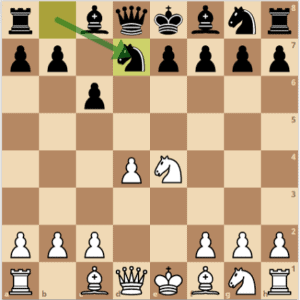
Starting position of the 4…Nd7 Variation
This variation is often named after the former World Champion Vassily Smyslov, who introduced it into his repertoire in the late 1950s. However, I have always associated this variation with two other very strong players. The first is the English Grandmaster Jonathan Speelman who has remained faithful to the variation for over 20 years. The second, and the real hero of the variation, is another former World Champion: Anatoly Karpov.
In the 1987 final eliminator match to challenge Garry Kasparov, Kar- pov found himself facing the rising star of world chess, Andrei Soko- lov. Sokolov looked particularly dangerous when playing his favourite 1.e4 so Karpov’s preparation centred on finding a system to blunt his attacking edge. He opted for a variation he had never played before: the …Nd7 Caro-Kann.
During the match Sokolov failed to win a single game against it (although, ironically, he did beat Karpov in a tour- nament game soon afterwards) while Karpov picked him off with the white pieces. Ever since Karpov has used this variation as his main weapon against 1.e4 and it was mainly due to his efforts that 4…Nd1 became so popular. It is certainly one of the most important lines of the Caro-Kann and in my view deserves to be renamed after Karpov (Smyslov never showed the same commitment to the variation). To avoid confusion, however, I will stick with the …Nd7 Caro-Kann, which is how I’ve known it during my chess career.
Why Play 4…Nd7?
The idea of 4…Nd7 is very simple. Black wants to develop his king’s knight but without incurring the pawn weaknesses after an immediate 4…Nf6. The system is extremely solid. Black’s basic plan is to quietly develop his pieces and then to counter in the centre with …c6-e5. After exchanging his c-pawn for White’s d-pawn Black should be left with a 1-0 central pawn majority (usually he has a pawn on e6) which may prove to be an advantage in the long run.
Who Should Play it?
This is not a variation that will suit all styles. Black players are warned that they often have to soak up a lot of early pressure. They should expect to get a compact, sometimes cramped, position but one without any weaknesses. If you are the sort of player who likes activity at all costs then look elsewhere. This is a variation for those who value, above all, a solid structure. I think it would be fair to describe 4…Nd7 as a provocative variation. White is encouraged to attack but Black knows that his rock-solid position won’t be easy to breakdown. However, once White starts to attack Black must be ready to counter in a vigorous manner.
WARNING: A sure recipe for disaster is to just sit there passively trying to fend off an attack without any aggressive intentions of one’s own.
To sum up, this is a variation where Black is not really looking for a fight but if White starts one…
What does White Play?
There are three main lines that White usually chooses from. The most solid and least ambitious is 5 Nf3. White usually develops quietly and hopes to obtain a small advantage to take into the middlegame. The system based on 5 Bc4 is more aggressive and there are many more dangers for Black in the early stages of the game. These two varia- tions are covered in this chapter.
The third line is 5 Ng5. This is a relatively new and dangerous system that developed because of the problems White was having in the other lines. This is now considered as the main line and is the subject of the next chapter.
There are a couple of other 5th moves that deserve a quick mention. The first is 5 Bd3, which often transposes after 5…Ngf6 6.Ng5. This move order was once popular but White players finally decided that it was less flexible than 5 Ng5 (mainly because of the reply 5…Ndf6) and it is not played so often anymore.
The other move worthy of a quick mention is 5.Qe2. This is occasion- ally played by those with an infantile sense of humor who are hoping that Black won’t notice that 5…Ngf6 allows 6 Nd6 mate. As long as Black stops this (5…e6, 5…Ndf6) then White should have no reason to laugh.
The Calm 5.Nf3
1.e4 c6 2.d4 d5 3.Nc3 dxe4 4.Nxe4 Nd7 5.Nf3 Ngf6 6.Ng3!?
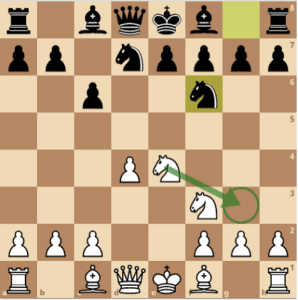
This move makes a lot of sense. White has more space so he keeps as many pieces as possible on the board. The alternative continuation, 6.Nxf6+
6…c5!?
This natural advance is designed to liquidate White’s advantage in the centre. If Black doesn’t play this move reasonably quickly he will find himself stuck in an extremely passive position. 6…e6 7.Bd3 e5 would transpose back into the main game.
7.Bd3
After 7.dxc5 Black should avoid 7…Nxc5 8.Qxd8+ Kxd8 with a clearly worse endgame in favour of 7…e6. As White can’t hang onto the pawn (8.b4 b6!) he usually settles for 8.c6 as after 8…bxc6 Black’s queenside pawn structure has been slightly compromised. However, Black remains very solid and if there is an edge for White it is a small one.
7…e6
A more aggressive plan is to exchange in the centre and fianchetto the king’s bishop. For example, 7…cxd4 8.Nxd4 g6 9.0-0 Bg7 was once thought to be quite a good position for Black but the latest view is that 10.Qe2! 0-0 11.Rd1 creates uncomfortable pressure along the d-file.
8.0-0 cxd4 9.Nxd4 Bc5 10.Nb3
10 Be3 and 10 c3 are the two other ways to deal with the attack on the knight . These also offer White chances of a small opening plus.
10…Be7
If Black had played …Be7 at once then we would have the same position except with the white knight on the more active d4-square.
NOTE: This …Bc5-e7 manoeuvre is quite common and can be see in a variety of other openings such as the Sicilian Defence and the French Defence.
Incidentally, 10…Bb6 may look more active but would be dubious as the bishop is likely to be required on the kingside for defensive duties.
11.Re1 0-0 12.Qf3
I am amazed to see this position assessed as equal by Encyclopaedia of Chess Openings. Surely it must be a little better for White? If nothing else, he has the more active pieces and a lead development. That is not to say that Black shouldn’t be able to draw with accurate play, but at this point White must be slightly better.
Theoretical?
This is a low priority section as far as learning theory goes, but Black will obviously do better if he has worked out lines beforehand against both 6.Nxf6+ and 6.Ng3.
Statistics
Overall after 5.Nf3 Ngf6 White has scored 52% from over 3000 games. Not a particularly good score (remember 54% is average) but what about if we look at the main lines a little more closely. With 6.Ng3 White scores about 54% while with 6.Nxf6+ he also scores around 54% providing he follows up with 7.Bc4 or 7.Ne5.
Below is an illustrative game showing 4…Nd7 Caro-Kann.
I could have presented a more spectacular game but the point is to show how Black soaks up the pressure in such positions.
Summarizing
- After the calm 5.Nf3 it is more promising for White to follow up with 6.Ng3 than 6.Nxf6+. He has more space and should keep as many pieces as possible on the
- The lines with 5.Bc4 are not as popular as they used to be and if he knows his stuff Black can equalise whether White plays with 8.Bb3 or 8.Bd3
Caro-Kann Advanced Variation
The Advance Variation (1.e4 c6 2.d4 d5 3.e5)is probably the line in the Caro-Kann that has expanded the most in recent times. Until about twenty years ago it had the reputation of been a rather timid variation that didn’t put Black under enough pressure in the opening.
This all changed when the sharp line with 4.Nc3 followed by g4 re- placed the rather dull 4.Bd3 as the main line against 3…Bf5. The 1980s saw many hair-raising theoretical battles with 4.Nc3 but by the end of the decade White appeared to have exhausted his ideas in this line. But the Advance didn’t stay out of the limelight for long as Nigel Short suddenly started to play the variation in a new way. He just developed his pieces very quietly (Nf3, Be2, 0-0 etc.) and relied on his extra space to make Black’s life difficult.
At first no-one believed this was a serious try for the advantage, but eventually it really caught on and by the mid 1990s it was dominating the Caro-Kann. Around this period Black players began to question the opinion that 3…c5 was a mistake and the efforts of players such as Igor Khenkin and Keith Arkell have now turned that into a fully viable alternative to 3…Bf5. And, as a final twist, in the last few years the star of the Short system has faded slightly and the sharp 4.Nc3 has risen, phoenix like, from the ashes.
3…c5 Variation
1.e4 c6 2.d4 d5 3.e5 c5!?
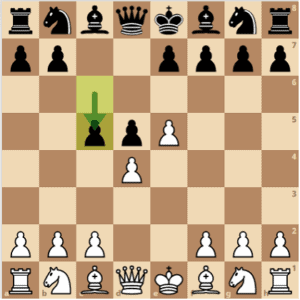
A second move by the c-pawn
This is a very thematic move but it has taken a surprisingly long time for Black to realize its potential. In the past it was often said that the Advance Variation was no good because Black could play a French Defense with his bishop outside the pawn chain. The move 3…Bf5 just became a given. Nobody saw beyond the fact that 3…c5 loses a pawn. But things have changed now and 3…c5 is gaining in popularity.
Some Caro-Kann players are beginning to feel that developing the bishop outside the pawn chain just gives White something to attack. Before we go any further:
WARNING: 3…c5 should be played only by those who are comfortable in French-style positions.
3.dxc5
The only testing move. After 4.c3 Black does indeed get an easy game by playing a sort of French defence with his light squared bishop ac- tively deployed outside the pawn chain. For example, 4…Nc6 5.Be3 cxd4 6.cxd4 Bf5 7.Nc3 e6 with equality.
4…e6
After this move the position is the same as after l.e4 e6 2.d4 d5 3.e5 c5 4.dxc5 except that it is still White to move. In effect, White has gained a tempo on an innocuous line of the Advance French. Is it still innocuous with the extra tempo? That is what we shall be endeavouring to answer.
Black has an equally important alternative in 4…Nc6.
5.Be3
White defends the attacked pawn with a developing move very natural. Still, there are some players who prefer to let the pawn go. The reason is they don’t like putting their bishop on a square that be- comes a target for a black knight landing on f5.
5…Nh6!?
Previously Black used to play 5…Nd7 but once Dautov produced 5…Nh6 Black players seemed to have ditched 5…Nd7 en masse. There is nothing particularly wrong with 5…Nd7. The main line runs 6.Bb5 Qc7 7.Nf3 Bxc5 8.Bxe5 Qxe5 9.Nc3 Ne7 and now I think 10.0-0 0-0 11 Re1 Ng6 is unclear but 10.Qd4 gives White chances of an edge.
And what about the move …Nh6? Isn’t Black worried about Bxh6 and the shattering of his kingside pawn structure? The answer is, not really. Connoisseurs of the French Defense will know that the knight often takes this route to f5. The move Bxh6 is an option for White, though an irritating one after having just played Be3, but it just leads to unbalanced positions where Black hopes his control of the dark squares will compensate for his pawn structure.
6.c3
White prepares to meet …Nf5 with Bd4. Recently there have been quite a few games with 6 Nf3. After 6…Nd7 White players got excited about the continuation 7.Bxh6 gxh6 8.c4 dxc4 9.Bxc4 as the position after 9…Nxc5 10.Qe2 seems to be in his favour. However, in the most recent game in this line Caro-Kann expert Igor Khenkin demonstrated that instead of recapturing the e-pawn Black should go after the e-pawn with 9…Bg7!. After 10.Qe2 Qc7 11.Bb5 0-0 12.Bxd7 Bxd7 13.0-0 Qxe5 14.Nc3 Bc6 15.Ne4 Qb4 16.Rfe1 Bxe4 a draw was agreed in Rabiega-Khenkin, Berlin 2001. At most White has a token edge in the final position.
6…Nf5 7 Bd4 Nxd4!?
At first glance it looks like an absolutely terrible move to take this bishop and straighten out White’s pawn structure. However, you will see Black’s reason as the play unfolds. In fact, most black players prefer 7…Bd7 to the text, the current view being that after 8.Nf3 Nc6 9.Qd2 f6 10.exf6 gxf6 11.Be3 White has slightly the better of a very complex game. However, such theoretical views are in a permanent state of flux.
8.cxd4 b6!
Black’s idea is to exchange off the powerful pawn on e5 and develop play on the e and b-files as well as against the weak pawn on d4.
9.Bb5+
A few unambitious white players have simply returned the pawn with 9 c6 here. Although that does keep the position relatively closed, Black has an easy game. 9.b4 leads to much sharper play and is obviously the critical test of Black’s strategy. Black appears to be coping fine.
9…Bd7 10.Bxd7+ Nxd7!?
This may well be an improvement on 10…Qxd7 11.cxb6 axb6 12.Ne2, which gave White an edge in Nisipeanu-Kachiani, Bad Wiessee 1997.
11.cxb6
After 11.c6 Nb8 Black wins back the pawn with a level game, while 11.b4 is still met by 11…a5.
11…Qxb6
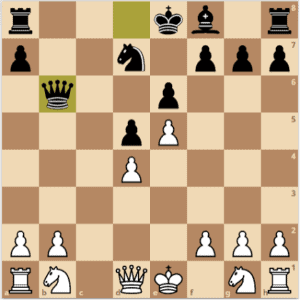
Black has compensation
It may look as if White is a pawn up for not much but the real question is, in fact, if he can survive the next few moves unscathed. Black threatens to take on b2. The obvious move is 12.Qd2, but after 12…Rb8 13.b3 (what else?) Black has the tactical shot 13…Nxe5!, the point being that after 14.dxe5 Bb4 15.Nc3 Black can now play 15…d4 with the better game. White probably should play 12.b3 but after 12…Bb4+ he will have to play 13.Kf1. I would prefer Black in this position.
We have, in fact, just rewritten chess theory as most sources claim that White is doing well after 9 Bb5+. Don’t forget, though, that there are still various alternatives that lead to a roughly equal game.
Theoretical?
It certainly helps to know what you are doing as the play can get quite sharp, but it would be fair to say that Black does not need to work as much to learn 3…c6 as 3…Bf5. White has less options here.
Statistics
Overall after 3…c5 White has scored 52% from 943 games. Not a very good score, but if we look in a bit more detail things start to improve for White. 25% of White players, for example, didn’t play 4 dxc5 and they only managed a paltry 42% with their collection of inferior lines. So if we take the position after 4 dxe5 as the starting point of the variation then White has managed a far healthier 56%.
Illustrative Game of Caro Kann Advanced Variation
3…c5 is becoming an increasingly popular way for Black to meet the Advance Caro-Kann. If nothing else it cuts down on the workload.






